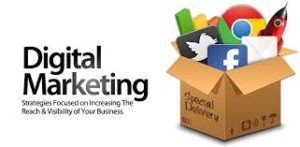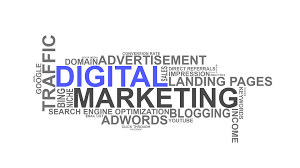Digital marketing is the use of digital technologies on the Internet to market products or services through mobile applications, display advertising, and any other digital media. The digital marketing channel is an internet-based system that can be created through digital networks to accelerate product pricing and move it from producers to consumer terminals.
In the 1990s and 2000s, the development of digital marketing changed the way technology was used for marketing brands and businesses. As digital platforms are increasingly integrated into marketing plans and daily life, and people are using digital devices rather than shopping in physical stores, digital marketing campaigns have become more common, search engine optimization (SEO), search engines Combining Marketing (SEM), Content Marketing, Influential Marketing, Content Automation, Event Marketing, Data-Driven Marketing, e-Commerce marketing, social media marketing, social media optimization, direct email marketing, display advertising, e-books, and compact discs and games have become mundane. Digital marketing extends to non-Internet channels, which provide digital media, such as TVs, mobile phones (SMS and MMS), callbacks, and reserved mobile ringtones. The expansion of non-Internet channels distinguishes digital marketing from online marketing.
Why Use Digital Marketing?
Although traditional marketing may exist in print advertising, telephony, or physical marketing, digital marketing can be done electronically and online. This means that there are many endless possibilities for brands, including email, video, social media, or website-based marketing opportunities.
Because there are many options and strategies associated with this in digital marketing, you can try creative and different marketing strategies within your budget. With digital marketing, you can use tools such as analytics dashboards to monitor campaign success and return on investment rather than traditional promotional materials like billboards or print ads.
Digital Marketing Development and Strategy:
Since digital marketing relies on ever-changing technologies, the development and strategy of digital marketing must have similar functions. This section is intended to limit or differentiate the important highlights that are available and in use as of press time.
- Segmentation: Segmentation in digital marketing is more focused to target specific markets in the business-to-business and business-to-consumer sectors.
- Influencer Marketing: Important nodes are identified in the respective communities and are called influencers. It is becoming an important concept of digital positioning. Affected advertising can be accessed through Facebook ads or Google AdWords advertisements or through sophisticated sCRM (Social Customer Relationship Management) software such as SAP C4C, Microsoft Dynamics, Sage CRM, and Salesforce CRM. Many universities now focus on effective engagement strategies at the master’s level.
All in all, Pull Digital Marketing is characterized by consumers actively seeking marketing content, while Push Digital Marketing is when marketers send messages and recipients are not actively looking for content.
- Collaborative Environment: A collaborative environment can be established between organizations, technology service providers, and digital agencies to optimize workload, resource sharing, reusability, and communication. In addition, organizations are inviting their customers to help them better understand how to serve them. This data source is called user-generated content. Most of them are obtained through the company’s website, where the company invites people to share ideas, which are then evaluated by other users of the site.
The most popular ideas will be evaluated and implemented in one form or another. The use of this method of acquiring data and developing new products can foster relationships between organizations and customers and generate ideas that would otherwise go unnoticed. UGC is low-cost advertising as it comes directly from consumers and can save advertising costs for the organization.
- Data-driven advertising: Customers generate a lot of data at every step on the customer journey, and brands can now use this data to activate their known audience through data-driven programmatic media purchases. User data can be collected from digital channels without exposing customer privacy (for example, when a customer visits a website, reads an email, or launches and interacts with a brand’s mobile app ), And the owner of a brand can also collect data from real customers. , Such as physical store visits and visits from CRM and sales engine datasets. Data-driven advertising, also known as people-oriented marketing or addressable media, enables brands to find loyal customers in their audiences and deliver real-time, more personalized communication that captures each customer’s moments and behaviors. Are highly relevant.
An important consideration today when deciding on a strategy is that digital devices have democratized the promotional environment.
- Remarketing: Remarketing plays an important role in digital marketing. This strategy allows marketers to post targeted ads before interest categories or defined audiences (often referred to as web searchers) who have searched for a specific product or service or visited a website for a purpose.
- Game advertisements: Game advertisements are advertisements present in computer or video games. One of the most common examples of advertising in sports is the billboards that appear in sports games. In-game advertisements can also appear as branded products such as guns, cars, or clothing, and exist as game status symbols.

Types and Uses of Digital Marketing:
Many channels facilitate digital marketing. An advertiser’s main goal is to find a channel that maximizes two-way communication and brings a higher overall return on investment for the brand. Many digital marketing channels are available, namely
Here we are! It’s time to be number one in the digital marketing genre. The types of online digital marketing include:
1. Search Engine Optimization (SEO)
It is the process of “ranking” your site higher on search engine result pages, which increases the natural (or free) traffic that the site receives. Channels that benefit from SEO include websites, blogs, and infographics.
There are several ways to use SEO to generate qualified traffic to your website:
- On-page SEO: This type of SEO focuses on everything “on-page” when viewing a website. By studying the search volume and intent (or meaning) of your keywords, you can answer questions for your readers and rank higher on the search engine result page (SERP) that generates queries.
- Off-page SEO: This type of SEO focuses on all the activities that occur “off-page” when optimizing your website. “What activities aren’t carried out on my own website that would affect my ranking?” You might ask. The answer is inbound links, also known as backlinks. The number of links to your publishers, as well as the relative “authority” of these publishers, will affect your ranking of the keywords you follow. By connecting with other publishers, writing guest posts on these sites (and linking back to your site) and drawing external attention, you get the backlinks you need to promote your site on all suitable SERPs.
- Technical SEO: This type of SEO focuses on the back end of the website and how the page is encoded. Image compression, structured data, and CSS file optimization are all technical SEO forms that can increase the loading speed of your website in search engines like Google, this is an important ranking factor.
2. Affiliate Marketing
Affiliate marketing is a type of performance-based marketing in which a business rewards one or more affiliates brought by the affiliate’s own marketing efforts by each visitor or customer.
Affiliate marketing is not considered a safe, reliable and easy means of marketing through online platforms. This is due to the lack of credibility of the members who can generate the required number of new customers. Because of this risk and poor affiliation, the brand is vulnerable to exploitation in the case of commissions claimed to be received in bad condition. Legal instruments may provide some protection for this, but there are limitations in recovering any losses or investments. Despite this, affiliate marketing allows brands to target smaller publishers and sites with less traffic. Brands that choose to use this type of marketing generally need to be aware of such risks and establish relationships with related parties and rules between related parties to ensure and mitigate related risks.
This is a performance-based advertisement, where you receive a commission to promote someone else’s product or service on your website. Affiliate marketing channels include:
- Hosting video ads through the YouTube Partner Program.
- Posting affiliate links from your social media accounts.
3. Pay Per Click (PPC)
PPC is a way to increase website traffic by paying publishers every time an ad is clicked. PPC is one of the most common types of PPC, which allows you to pay for the top spot on the Google search engine results page at the “per click” value of the links you have given. Other channels where you can use PPC include:
- Paid Advertising on Facebook: Here, users can pay to customize videos, image posts, or slideshows that Facebook will publish in the newsfeed of people who match your business audience.
- Twitter Advertising Campaign: Here, users can pay to put a series of posts or profile badges in news feeds of specific audiences, all of which are dedicated to the specific goals of your business. This goal can be website traffic, more Twitter followers, Twitter interactions, and even app downloads.
- Sponsored Messages on LinkedIn: Here, users can pay to send messages directly to specific LinkedIn users based on their industry and background.
4. Display advertising
Display ads are advertisements that range from banner ads or other advertising formats on a website or application or social media, including text, images, flash, video, and audio. The main purpose of display advertising is to deliver general advertising and brand messages to site visitors.
As its name implies, online display advertising is responsible for presenting promotional messages or ideas to consumers on the Internet. These include a variety of ads, such as advertising blogs, web, interstitial ads, contextual data, ads on search engines, classified ads or dynamic ads. This method can be tailored to specific audiences from different types of locals to see specific ads, and these changes can be found to be the most productive element of this method.
5. Email marketing
Email marketing is considered cheaper than other forms of digital marketing; It is a way of quickly delivering information to existing or potential customers, such as its value proposition. However, recipients can disturb this communication channel, especially for new or potential customers, so the success of email marketing depends on the language and visibility used. In terms of visual appeal, there are indications of using graphics / visual effects related to the message you’re trying to send, but fewer visual graphics to use with the initial email, which in turn is more personalized. Feels more effectively. E-mail. In terms of language, style is a major factor in determining the appeal of an email. Compared to the formal style, using a casual tone can give the email a warm, gentle and seductive experience. For the combination; It is recommended to make the most; Not using graphics / visual and casual language. Conversely, the lack of visual appeal and formal language style are considered the most ineffective methods.
6. Search Engine Marketing
Search engine marketing (SEM) is a form of Internet marketing that involves website promotion by increasing the visibility of a website in a search engine results page (SERP) primarily through paid advertising. SEM may incorporate a search engine optimization feature that can adjust or rewrite website content and website architecture to achieve higher rankings on search engine results pages and improve pay-per-click (PPC) listings.
7. Social Media Marketing
The term “digital marketing” has many marketing aspects because it supports the different channels used in it, including social media. When we use a social media channel (Facebook, Twitter, Pinterest, Instagram, Google+, etc.) to market a product or service, the strategy is called social media marketing. It is a process in which strategies are developed and executed to attract website traffic using different social media platforms or to attract buyers’ attention through the web.
Social Networking Services-Social networking is an online platform that people can use to build social networks or build social relationships with others who have similar personal or professional interests, activities, backgrounds or real-life connections.
This approach promotes your brand and content on social media channels, increases brand awareness, increases traffic, and attracts potential customers to your business. Channels you can use in social media marketing include:
- Snapchat
8. Online public relations
Online public relations (E-PR, Digital PR) exerts the influence of network relations among netizens. Its purpose is to make satisfactory comments on the news of the organization, its products and services, and the target audience. Popular comments have been reduced to a great extent. Online public relations show a difference from traditional public relations. One of them is associated with its platform. Compared to traditional public relations channels (such as television, radio, and print media), web systems for online public relations are different from search to social platforms.
Is digital marketing applicable to all businesses?
Digital marketing can serve any business in any industry. No matter what product your company sells, digital marketing still needs to establish a buyer role to identify the needs of the audience and create valuable online content. However, this is not to say that all businesses should implement digital marketing strategies in the same way.
B2B Digital Marketing:
If your company is business-to-business (B2B), then your digital marketing efforts can be generated around online leads, with the ultimate goal of talking to a seller. Therefore, the role of your marketing strategy is for your sales staff to attract and convert the highest quality leads through your website and supported digital channels.
Outside of your website, you can choose to focus on a business-focused channel like LinkedIn, and your audience is spending that time online.
B2C Digital Marketing:
If your company is a business-to-consumer (B2C) business, then depending on the product’s price point, the goal of your digital marketing effort is to attract people to your website and make them customers without talking to them.
As a result, you may be less likely to focus on “leaders” in the traditional sense, and more likely to focus on building an accelerated buyer journey, from the moment someone visits your website to the moment they make a purchase. Compared to a B2B business, this usually means that your product features are in a higher marketing channel in the marketing channel, and you may need to use a stronger call to action (CTA).







